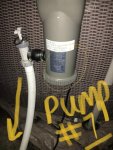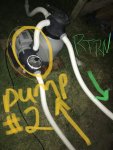Hi all,
Got a question: Bought this pool (5360 gallons) separate from the sand filter&pump (2100gph ). The filter and pump that came with is a cartridge 1500gph...good in the bathtub maybe but not in my pool.
So we have this sand filter pump and no easy place to hook up to because there are only 2 holes and the one is very large and intended for the original skimmer/filter/pump unit (built altogether).
I’m wondering if I can hook the sand filter to the original pump (pressure side) and also, could I run both simultaneously in-line?? Has this been attempted and are there hard lessons to be taught here??
I learned about proper flow rates by volume and the input vs. output of pumps (pool school obviously) and am concerned I might not want to be forcing the flow through my sand filter...sort of like ram-air, but...ram-water??
I’d be grateful for any advice on how to proceed. Thanking you.
(I have pics!?)
Got a question: Bought this pool (5360 gallons) separate from the sand filter&pump (2100gph ). The filter and pump that came with is a cartridge 1500gph...good in the bathtub maybe but not in my pool.
So we have this sand filter pump and no easy place to hook up to because there are only 2 holes and the one is very large and intended for the original skimmer/filter/pump unit (built altogether).
I’m wondering if I can hook the sand filter to the original pump (pressure side) and also, could I run both simultaneously in-line?? Has this been attempted and are there hard lessons to be taught here??
I learned about proper flow rates by volume and the input vs. output of pumps (pool school obviously) and am concerned I might not want to be forcing the flow through my sand filter...sort of like ram-air, but...ram-water??
I’d be grateful for any advice on how to proceed. Thanking you.
(I have pics!?)




